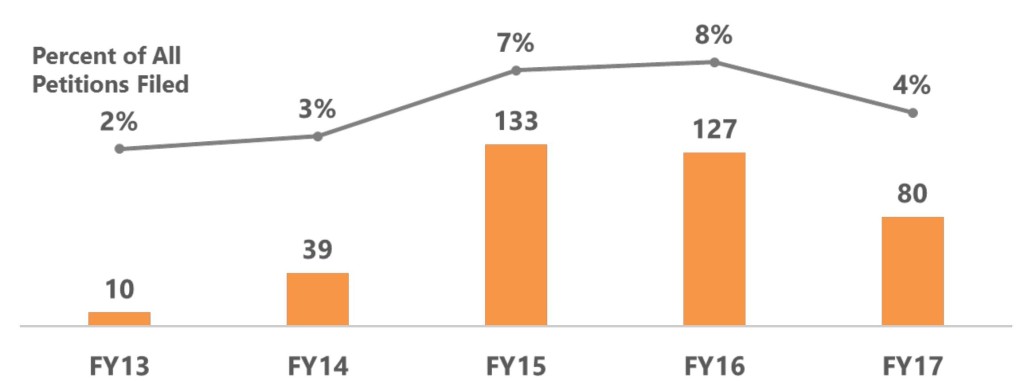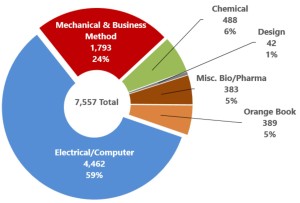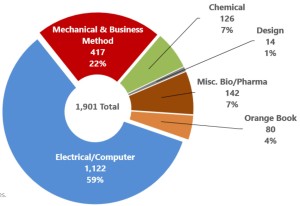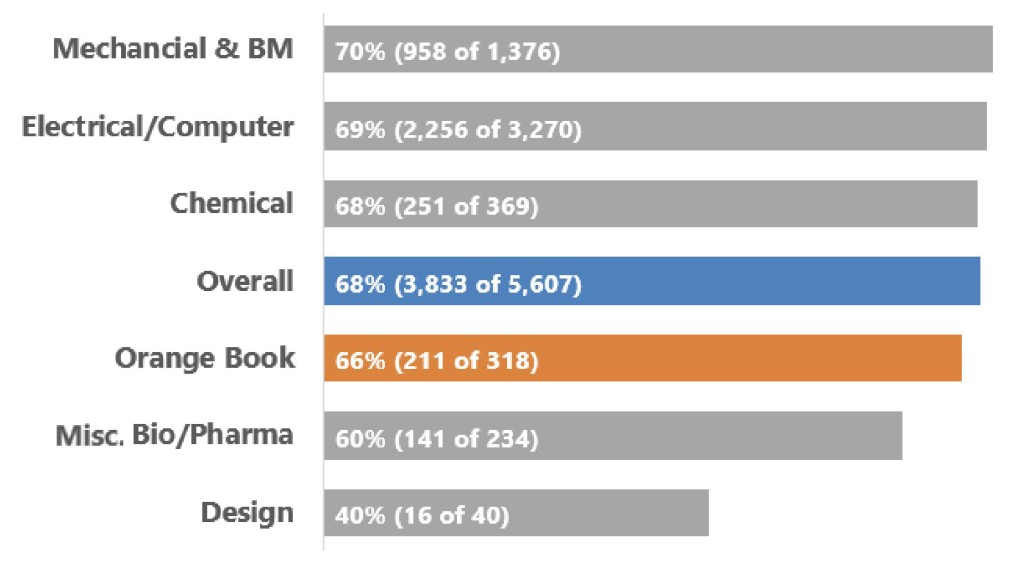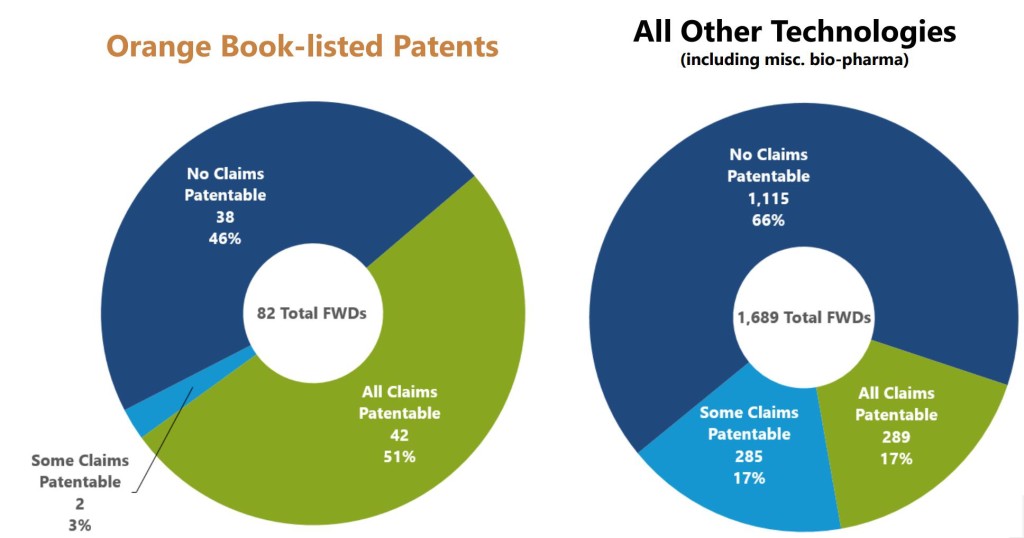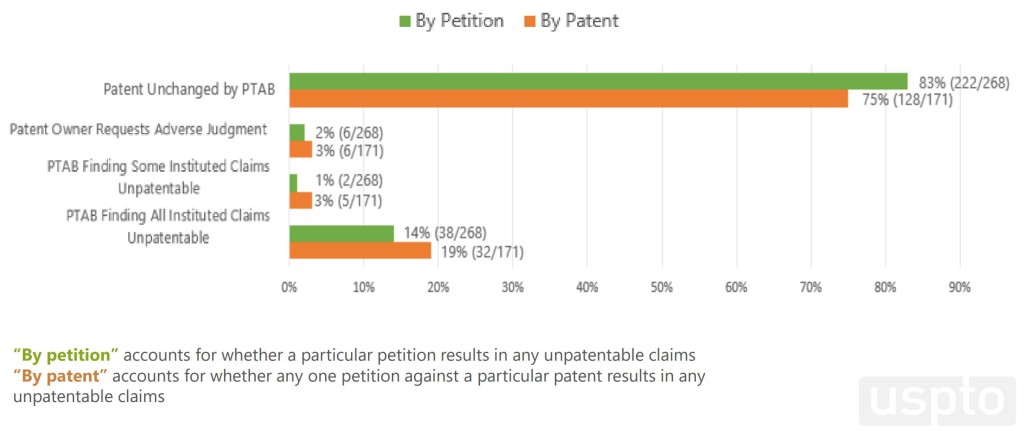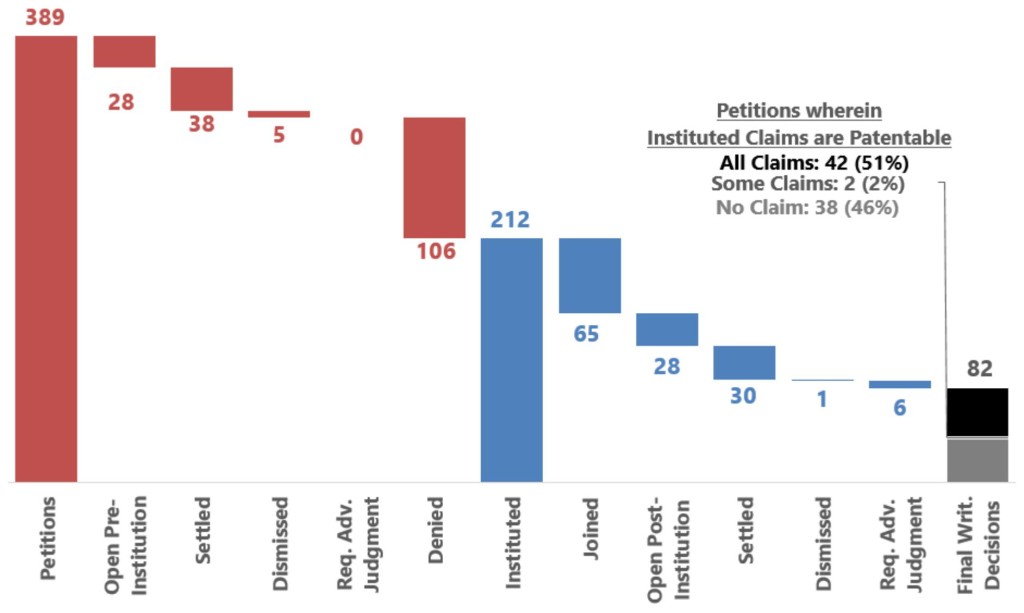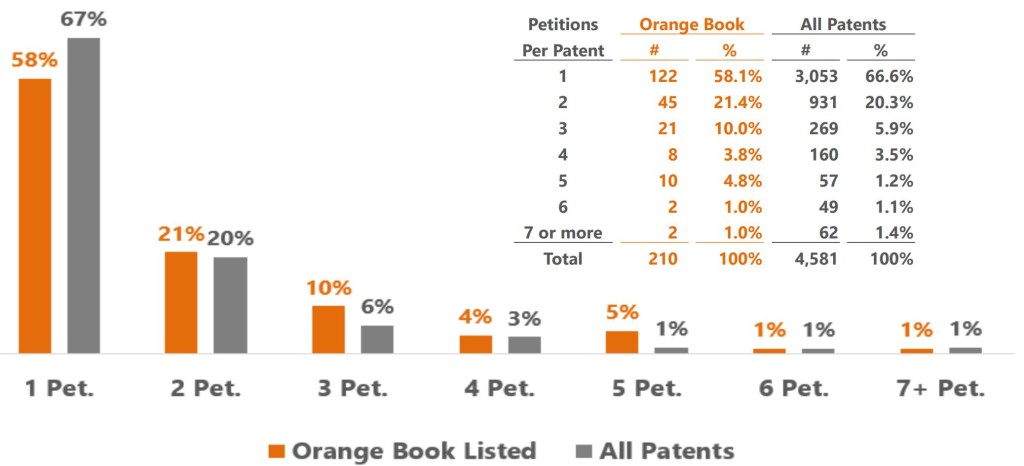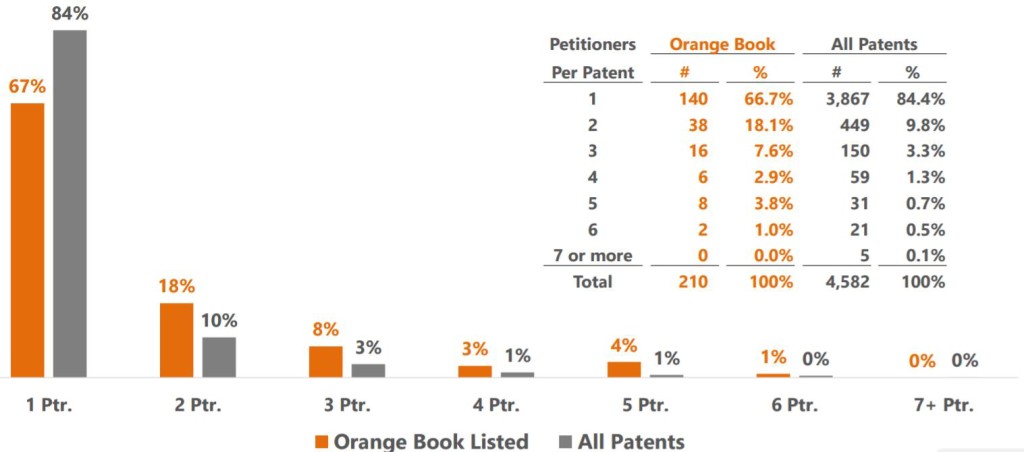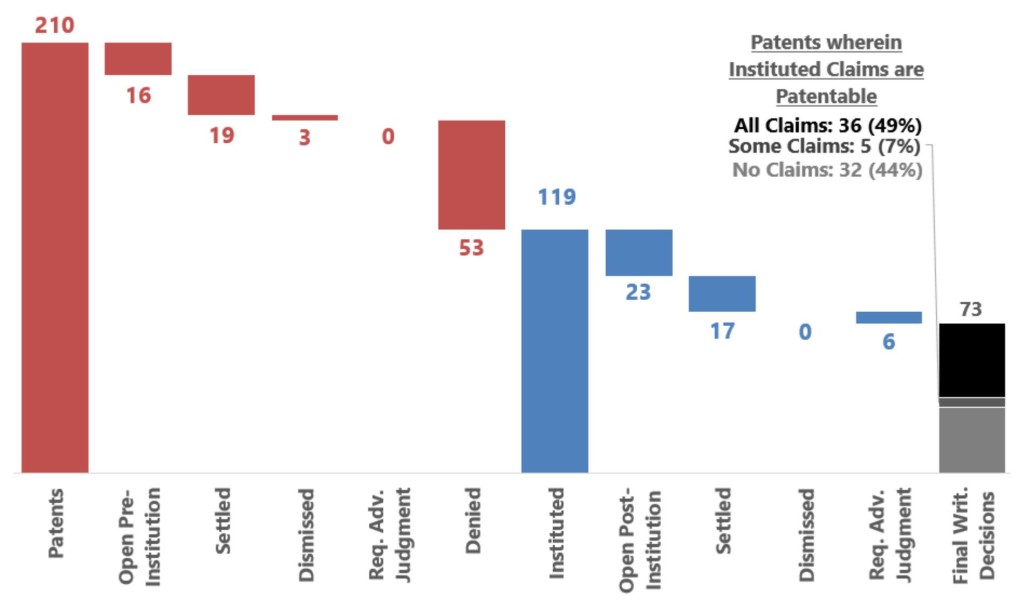The USPTO recently issued a study concerning AIA trial proceedings challenging Orange Book-Listed patents.1 The study was presented by the PTAB in a webinar entitled “New PTAB Studies in AIA Proceedings: Expanded Panels and Trial Outcomes for Orange Book Listed Patents” held on March 13, 2018.
Orange Book-Listed patents cover FDA-approved drug products. The patents are listed in the publication Approved Drug Products with Therapeutic Equivalence Evaluations, commonly referred to as the Orange Book. Orange Book-Listed patents are often the subject of litigation under the Hatch-Waxman Act, which provides for an abbreviated regulatory approval pathway for generic drug products. In its study, the PTAB specifically considered how Orange Book-Listed patents have fared in three key areas of AIA trial proceedings: (1) institution, (2) final written decisions, and (3) situations involving multiple petitions and multiple petitioners.
1. Number of Petitions Filed Challenging Orange Book-Listed Patents
Fig. 1 below shows the number of petitions filed challenging Orange Book-Listed patents (“Orange Book petitions”), broken down by fiscal year. Also provided is the percentage of such Orange Book petitions in comparison with the total number of petitions filed at the PTAB. In FY2017, 4% of petitions filed at the PTAB were challenges of Orange Book-Listed patents. This is down from 8% in FY2016.
Figs. 2A and 2B break down the number of petitions filed at the PTAB based on technology (including Orange Book-Listed patents as belonging to their own “technology” category). Fig. 2A provides all-time statistics through FY 2017, and Fig. 2B provides statistics for FY2017 alone. As can be seen from this data, the percentage of Orange Book petitions filed in FY2017 (4%), in relation to the total number of petitions filed at the PTAB, is similar to the percentage of Orange Book petitions filed since the inception of AIA trial proceedings (5%).
This data shows that (1) the number of Orange Book petitions filed through FY2017 constitutes a relatively small fraction of the total number of petitions filed at the PTAB, and (2) the percentage of Orange Book petitions (based on total petitions filed) did not increase in FY2017 in comparison with historical percentages. While drug patents have featured prominently in recent AIA trial proceedings (including the Restasis® IPRs relating to tribal sovereign immunity and IPRs brought by Kyle Bass’s Coalition for Affordable Drugs), as a whole, the filing of petitions challenging Orange Book-Listed patents is not on the rise.
2. Institution Rate of Petitions Challenging Orange Book-Listed Patents
Fig. 3 shows the institution rates of petitions filed at the PTAB based on technology (including Orange Book-Listed patents). As can be seen from this data, the institution rate of Orange Book petitions through FY2017 is 66%. This is comparable to the overall institution rate of 68% for all petitions irrespective of technology.
3. Outcomes of Petitions Challenging Orange Book-Listed Patents
Fig. 4 shows outcomes in final written decisions of petitions filed at the PTAB based on technology (including Orange Book-Listed patents). Through FY2017, the PTAB has issued 82 final written decisions concerning Orange Book petitions. In 51% of the final written decisions dealing with Orange Book-Listed patents, all claims were determined to be patentable. In comparison, for all other technologies, all claims were determined to be patentable in only 17% of the final written decisions.
Further, as can be seen from the graph on the right, two-thirds of petitions challenging non-Orange Book-Listed patents resulted in no claims being found patentable in the final written decision. By comparison, only 46% of petitions challenging Orange Book-Listed patents resulted in no claims being found patentable. The data shows that Orange Book-Listed patents have fared much better than patents covering other technologies in AIA trials that reach final written decision.
Fig. 5 below provides data concerning the outcomes of petitions filed against Orange Book-Listed patents, both on a “by petition” and a “by patent” basis.
4. Status of Petitions Challenging an Orange Book-Listed Patent in Comparison with All Other Technologies
Fig. 6 below compares the status of petitions challenging an Orange Book-Listed patent with the status of petitions challenging patents of other technologies, through FY2017. The percentages of Orange Book petitions that reached final written decision (21%), settlement (17%), and were denied institution (21%), are not dramatically different from such percentages for petitions challenging patents of all other technologies. Interestingly, joinder occurs much more frequently in Orange Book petitions (17%) than petitions challenging patents of all other technologies (4%).
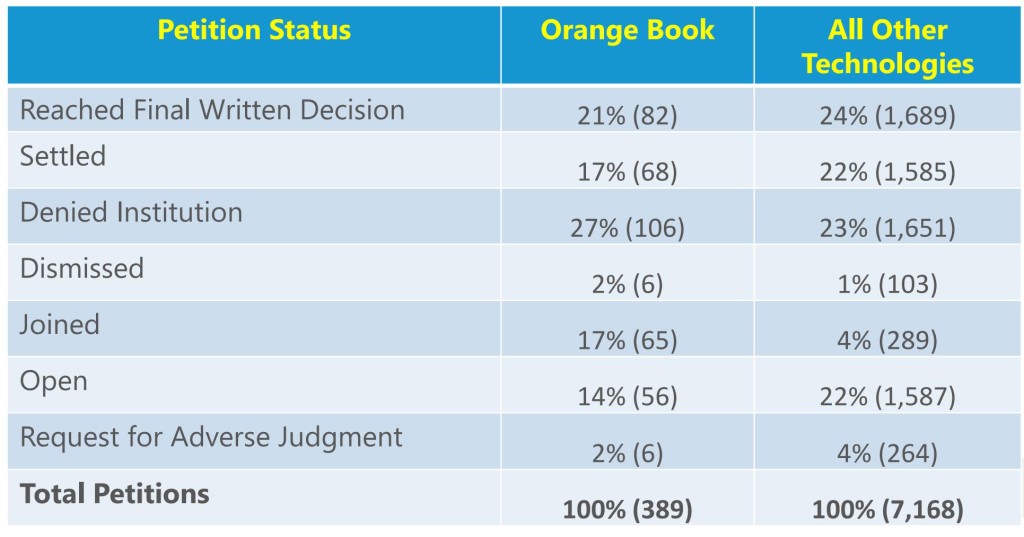
Fig. 6: Comparison of Outcomes of Orange Book Petitions with Non-Orange Book Petitions (9/16/12 to 9/30/17)
Fig. 7 shows the disposition of all petitions challenging an Orange Book-Listed patent, presented in the same “waterfall” graphic format as provided in the monthly AIA statistic updates provided by the USPTO.
5. Multiple Petitions Filed Against the Same Orange Book-Listed Patent
In AIA trial proceedings, the same patent is sometimes challenged in more than one petition, and sometimes by more than one petitioner. Figs. 8 and 9 below explore these situations in the context of Orange Book-listed patents. Specifically, Fig. 8 compares the number of petitions filed against a single Orange Book-Listed patent, with the number of petitions filed against a single patent regardless of technology.
In its study, the PTAB noted that 80% of all challenged Orange Book-Listed patents have one or two petitions, compared to 87% of all challenged patents. However, as can be seen from Fig. 8, the instances in which an Orange Book-Listed patent was challenged by two or more petitions (42%) is somewhat greater than the instances for all patents (33%).
Fig. 9 below shows the percentage of challenged patents by number of petitioners. As can be seen from Fig. 9, for Orange Book-Listed patents, 67% of the patents were challenged by one petitioner, and 33% of the patents were challenged by more than one petitioner. This is in comparison to 84% and 16%, respectively, for patents of other technologies.
Fig. 10 below shows the status and outcomes of Orange Book-Listed patents challenged in AIA trial proceedings. As seen from Fig. 10, when viewed from the perspective of each challenged patent (as opposed to each petition), trial has been instituted for 119 patents, and institution has been denied for 53 patents.
6. Conclusion
Orange Book-Listed patents have fared better in AIA trial proceedings than patents directed to other technologies. The institution rate of Orange Book petitions (66%) is substantially the same as the overall institution rate (68%) of petitions irrespective of technology. However, in cases which reached final written decision, all claims were determined to be patentable in 51% of the proceedings involving Orange Book-Listed patents. In comparison, in challenges of patents involving all other technologies, all claims were determined to be patentable in only 17% of the final written decisions. Further, 83% of all petitions challenging Orange Book-Listed patents resulted in the patent being unchanged by the PTAB.
The data provided by the PTAB may address concerns that Orange Book-Listed patents are being challenged far more often, and by far more petitioners, than other patents. In its study, the PTAB noted that (1) 80% of all challenged Orange Book-Listed patents have one or two petitions, compared to 87% of all challenged patents, and (2) 85% of all challenged Orange Book-Listed patents have one or two petitioners, compared to 94% of all challenged patents. Importantly, the data concerning multiple petitions includes petitions filed through FY2017. The vast majority of such petitions were filed prior to the PTAB’s decision in General Plastic Industrial Co., Ltd. v. Canon Kabushiki Kaisha, IPR2016-01357, Paper 19 (Sep. 6, 2017) (precedential as to section II.B.4.i.). As discussed in our previous article, the stringent factors for granting institution of follow-on petitions set forth in General Plastic may curtail the filing of multiple petitions against the same patent.
1 Unless otherwise noted, all data discussed herein was obtained from the USPTO study concerning outcomes of AIA trial proceedings challenging Orange Book-Listed patents dated March 13, 2018.
